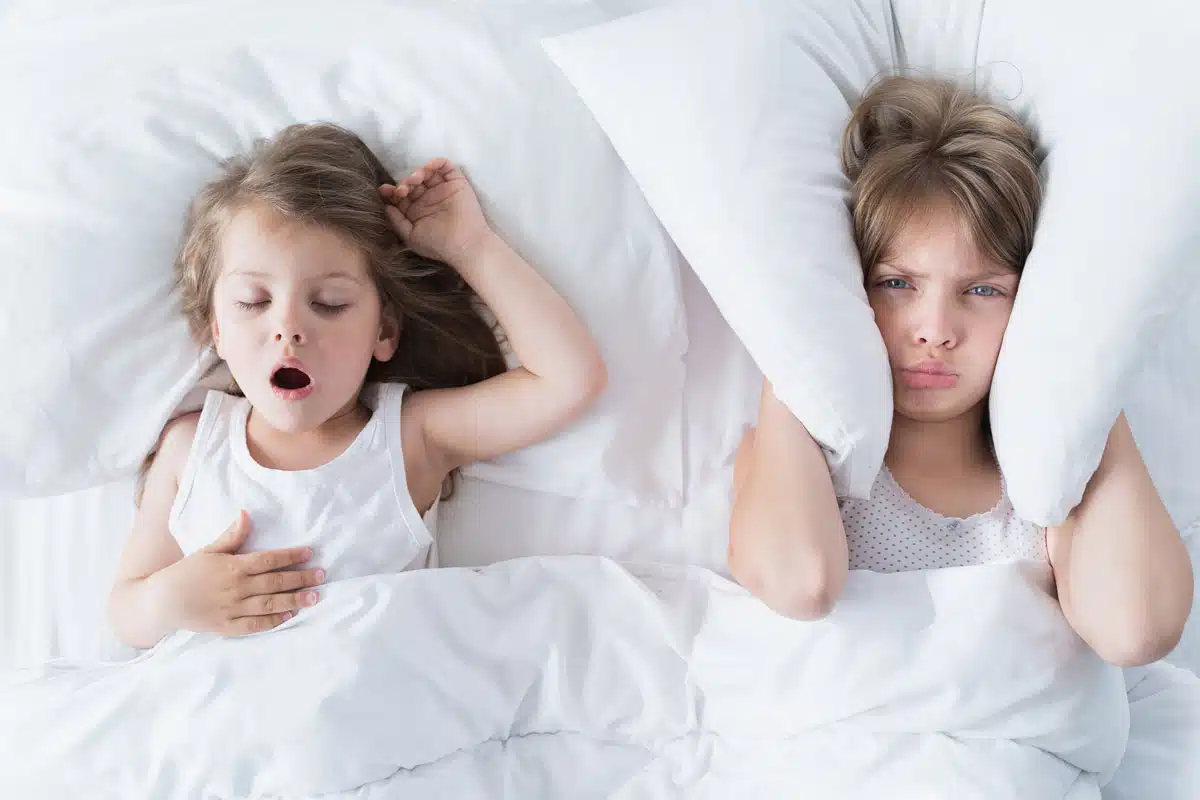
Habitual snoring is very common in adults, affecting more men than women and the incidence rises with age. But what about snoring in children… what should you do if your toddler or child snores?
Not only can the fact that your young child snores be surprising, but so too can its volume and severity. How can such a small person make so much noise?
While noisy breathing in children is common, actual snoring in children is not normal; and while many cases are of little concern, some can be quite serious – especially if the child has obstructive sleep apnoea (OSA).
According to NZ children’s hospital Starship:
- 10% of NZ children snore most nights
- Up to 5% of NZ children have obstructive sleep apnoea (OSA)
- The cardinal feature of OSA in children is snoring three or more nights per week
- In children, the peak age for OSA is between ages 3-6 years
- Children with OSA are inclined to be inattentive or hyperactive
Good quality, adequate sleep is important for everyone – but none more so than for developing, growing children.
Sleep deprivation has widespread consequences. It’s crucial that you understand why your child is snoring and when medical consultation and/or intervention is required.
What Causes Snoring in Children?
All of us occasionally snore. Basic snoring in children is the same as it is in adults. When we fall asleep, the muscles relax, including those muscles of the mouth, neck, and throat. This causes the tissues to vibrate and, in some cases, fall in on themselves, impeding the smooth flow of air in the upper airways during breathing. This can elicit snoring, as the air can’t flow as smoothly through the upper airways.
Basic snoring that is minor, infrequent, and of short duration is usually no cause for alarm and will not negatively impact your child’s life.
Not all snoring, however, is the same.
- Primary Snoring is the above mentioned light, periodic snoring that is usually nothing to worry about. Of children who do snore, 70% are experiencing primary snoring.
- Most snoring in children (and childhood obstructive sleep apnoea or OSA) is caused by enlarged or swollen tonsils and adenoids. These are glandular tissues situated in the back of the throat (tonsils) and between the nose and the throat (adenoids). These are small organs that are part of the immune system. In response to allergies and infection, they swell and can become inflamed. A lot of children have chronically enlarged tonsils and adenoids; for most, they will shrink by early adulthood. The tonsils and adenoids can cause snoring, and may also obstruct the airways, disturbing sleep and causing OSA.
- Congestion is another very common cause of childhood snoring. Swollen, inflamed nasal passages prevent smooth airflow for nasal breathing. Allergies and asthma can have the same effect.
- Obesity significantly increases a child’s snoring and OSA risk. This is particularly prevalent in children who have extra fat in the neck, as this contributes to narrower airways.
- Craniofacial anatomy can vary dramatically between people. Some of us are born with certain characteristics that contribute to snoring. Others may acquire them from an injury. Examples of this include a deviated septum, a cleft lip or palate, a long or floppy uvula, or a larger-than-average tongue.
- Poor Air Quality including cigarette smoke, vapour, and pollution plays a role in irritated and inflamed airways and associated snoring
- Children with disorders such as Down syndrome, cerebral palsy, muscular dystrophy, spina bifida, and sickle cell disease have an increased prevalence of snoring.
When is Snoring in Children a Red Flag?
Occasional, mild snoring is usually not a reason for concern. Frequent or severe snoring, however, is a sign that you should check with your GP.
Snoring often, or snoring that interrupts sleep can signify sleep-disordered breathing (SDB). This may be mild, moderate, or severe. SDB is not as serious as OSA, however, it can have similar ramifications (see below).
OSA affects up to one in twenty children in NZ. It is a serious medical issue that causes major disruption to sleep and can dramatically impact the child’s health and quality of life – both now and in the future.
Snoring in children may cause:
- Problems concentrating
- Poor attentiveness and memory issues
- Learning difficulties
- Daytime sleepiness
- Hyperactive behaviour
- Crankiness, grumpiness, oversensitivity
- Chronic sore throat
- Behaviour problems
- Possible link with ADHD
- Cardiovascular problems
- Disruption to the sleep of other family members, especially siblings who share their room
When to Get Help:
- Your child snores 3+ nights per week
- Snoring is loud and disruptive
- Mouth breathing during sleep and/or when awake
- Short pauses in breathing during sleep
- Your child sleeps with their neck or chin extended
- Gasping when sleeping
- Sweating during sleep
- Restless sleep
- Difficulty getting up in the morning
- Daytime tiredness
- Headaches on waking
- Learning difficulties
- Behaviour issues during the day
- Irritability, aggression, crankiness
- Frequent daydreaming or “zoning out”
- Obesity
- Bedwetting
- ADHD diagnosis
- Below-average weight gain for their age
Treatments for Snoring in Children
Consult with your GP to help understand why your child snores.
The treatment approach will depend on the cause of the snoring.
- Minor, infrequent snoring will usually resolve on its own and generally requires no treatment.
- Treat asthma and allergies appropriately to help reduce inflammation and irritation in the nose, throat, and trachea. Remove irritants from the child’s bedroom, including pets, feather or down pillows and comforters and use a humidifier.
- Set and enforce a consistent bedtime schedule for your child from as early an age as possible. Reduce their exposure to light and prohibit/limit screen time for at least two hours before bed. The bedroom should be quiet, cool, dark, and comfortable. Encourage your child to sleep on their side.
- Chronically enlarged, inflamed, or frequently infected tonsils or adenoids will possibly need to be removed. This can significantly improve or even fully resolve childhood snoring. Your GP will be able to refer you to a paediatric Ear, Nose, and Throat surgeon referral if necessary.
- An overweight or obese child should be encouraged to eat healthier and participate in physical activity. Even losing a little excess body weight can help alleviate snoring and improve overall health and well-being.
- If you smoke, especially at home, quit.
- If you suspect your child might have OSA, they need to see your GP promptly. A sleep study and testing will be required and specific strategies will need to be implemented to manage the issue. OSA is a very serious condition; your child’s immediate and long-term health and well-being depend on treatment.
Most children with OSA will have their tonsils and adenoids removed. For those whose OSA persists, CPAP may be recommended.
Every parent wants their child to be as healthy and happy as possible. Do what you can to achieve this by getting help for their snoring.
Snoring Treatment Device for Adults – ApneaRx
Do you snore? Just like for your children, addressing your snoring is essential for your sleep quality and overall health.
ApneaRx is an effective anti-snoring solution that can help alleviate snoring in adults and is also suitable for use by people with OSA (mild to moderate) alongside CPAP for sleep apnoea treatment.
ApneaRx is a mouthguard to stop snoring: a mandibular advancement device that gently moves the lower jaw slightly forward during sleep, thereby opening the airways and promoting clearer breathing.
ApneaRX is suitable only for use by adults over the age of 18 years.
Explore ApneaRx and Shop Now.


